Ten hours after combat ceased, a fresh wave of Russian missiles was launched against the Chinese bases. Each salvo consisted of only four missiles and the salvos were forty seconds apart. Two Russian Osa class ships of 7750 tons were within eight million kilometres of Earth, two similarly sized Zhdanov class were at twenty-four million kilometres while a 7750 ton Azov and a 15,450 Bodry were at thirty million. Which ship was firing the missiles was unknown. The two Kalinins were still in lunar orbit while the Neustrashimy and the two Minsk class ships had moved out beyond the orbit of Mars, along with a dozen 20,200 ton Krivaks, which were probably colony ships. Twenty-four waves of missiles attacked without scoring a single hit.
The pair of Russian Osas followed the missiles in, arriving at the Earth/Moon system twenty minutes after the last salvo. They crossed the Moon’s orbit heading directly for Earth. With the Russian ships at 125,000 kilometres, three strength-3 energy weapon impacts were detected in Earth orbit. Whether this was the Chinese laser-armed bases defending against missile attack or the Russian destroyers attacking the bases was unknown. Twenty seconds later, with the destroyers at 70,000 km, Jovian sensors recorded five strength-5 energy weapon impacts. As the bases had never generated more than strength-3 hits, this confirmed that the impacts were due to offensive fire from the Osas. Simultaneously the Russian destroyers were struck by several strength-1 hits. They withdrew to 100,000 kilometres, outside the range of the Chinese lasers, and continued fire.
Five minutes after the first shot was fired, one of the resilient Chinese laser-armed bases exploded. The other two followed within a few brief minutes. The Russian destroyer closed to point blank range, inflicting strength-10 hits, and blasted the remaining two missile-armed bases into scrap metal. With the orbital defences eliminated, the Russian destroyers opened fire on the huge Chinese shipyard complex, which was more than a million tons. While the bulk of the Chinese fleet watched from more than a billion kilometres away, the Russian warships completely obliterated their orbital industry. A stray salvo of Chinese missiles had proved to be very expensive indeed.
The People’s Republic of China was extremely fortunate that the Russian Federation had apparently exhausted its available anti-ship missiles, although there were six Russian destroyers on the far side of the inner system, out near the asteroid belt, and two of those were now heading for Earth. Meanwhile, a Russian Azov class destroyer was picking up survivors from some of the destroyed Chinese ships, probably for interrogation purposes. Twenty-four hours after the destruction of the shipyard, the Chinese population on Earth was struck by forty-four strength-1 ground-burst detonations spread across three salvos. The best theory among the JNI analysts was that the Russians were firing missiles as soon as they constructed them.
Sixteen hours after the attack on Earth, Jovian sensors detected signs of combat between the asteroid belt and Jupiter’s leading Trojan asteroids. Four Russian ships, comprising a Frunze, a Moskva and two Kuznetsovs, all of which were 7750 tons, came under missile attack. Ten inbounds were destroyed by strength-3 energy weapon impacts but five struck one of the Kuznetsovs with strength-10 warheads and the destroyer fell out of formation. Active sensors emissions from two Chinese FACs were within fourteen million kilometres of the Russian ships but they had recently passed the Russians en route to Earth and if they were the launching ships it seems likely they would have fired much earlier. A much larger Chinese task group was approximately one hundred and twenty million kilometres away and comprised a pair of Kaifeng class 25,350 ton battleships, five ships of 16,900 tons and a single destroyer-sized vessel. The Chinese force was passing through the leading Jupiter Trojans as it headed into the inner Sol system. The much smaller Russian task group had moved out to meet them.
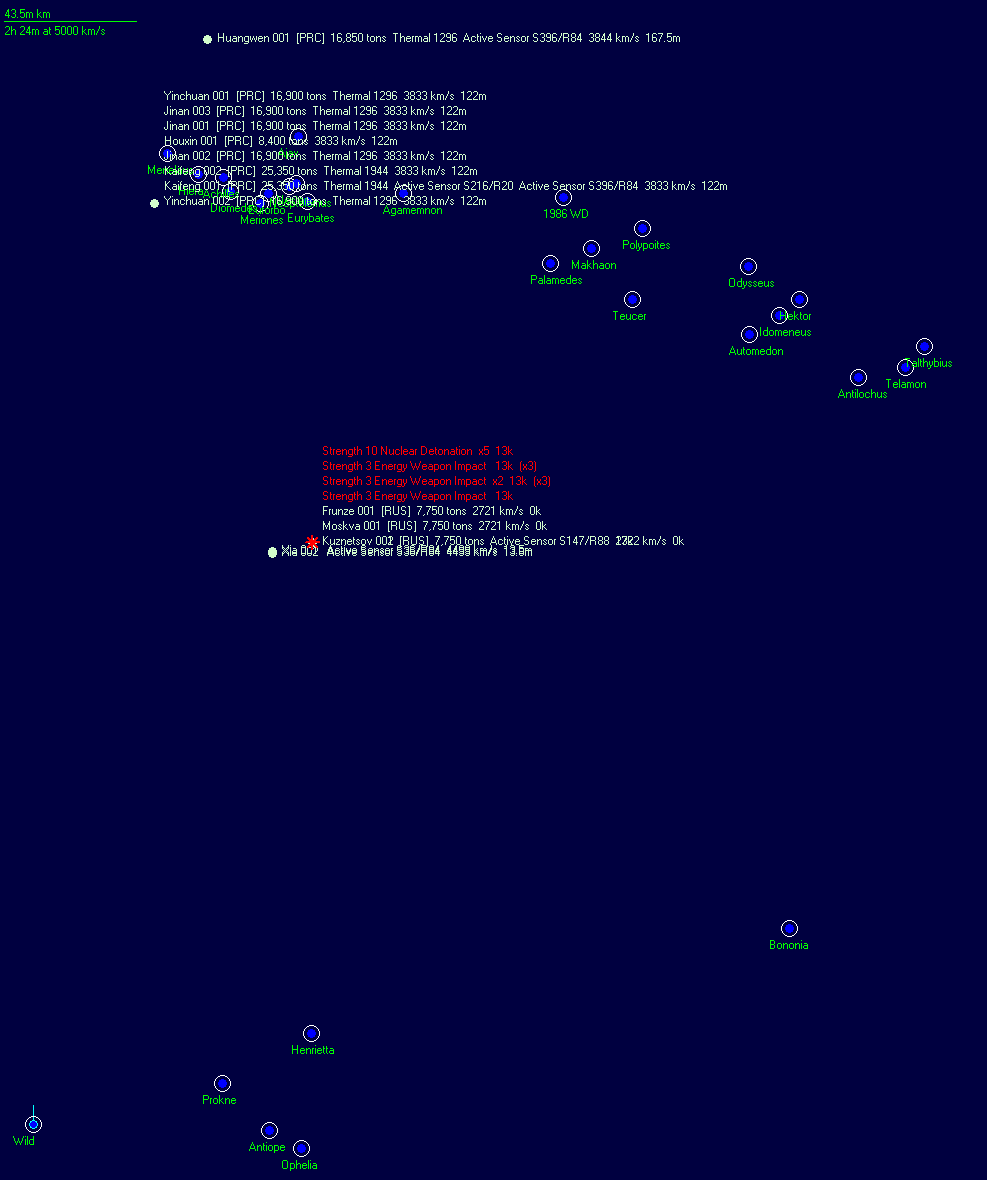
Twenty seconds later a second salvo arrived. The damaged Kuznetsov was separated from the main body and took five more hits, although it managed to destroy three missiles. The other three ships killed eleven missiles between them. The third salvo inflicted five hits on the Moskva, which also dropped out of formation. The fourth salvo only scored three hits but they were followed by a strength-25 secondary explosion that destroyed the Frunze. Despite their successes near Earth, the Russian forces were spread out and could not handle the powerful Chinese fleet in deep space. The second Kuznetsov, the only undamaged ship in the Russian task group, suffered eleven hits in the fourth salvo and there was no sign of defensive fire. It was destroyed by the fifth salvo. The two remaining ships, both reduced to half speed, struggled onwards. Moskva took five hits and blew up, leaving the first Kuznetsov. Two and a half hours later, a second wave of missiles arrived and a fourth Russian wreck appeared.
Five hours after the loss of the Russian task group, the Chinese population on Earth came under renewed attack. A dozen strength-9 ground bursts were detected, the first use of anti-ship missiles against the surface, as opposed to the much smaller warheads of the Russian AAMs. Whether the target was ground forces or population centres was unknown but even attacks on the former would result in considerable collateral damage. The source of the attack was probably a pair of Russian destroyers that had broken away from the task group recently destroyed by the Chinese and headed for Earth instead. They were now only thirty million kilometres away.
Every forty seconds another dozen warheads hit. One hundred and sixty-eight strength-9 detonations ravaged the population of the People’s Republic before the bombardment ceased. At first Jovian Naval Intelligence believed the Russian destroyers had run out of missiles but within a few minutes the truth became apparent. The Chinese had surrendered to the Russians to avoid further planetary bombardment. From news reports, the Chinese casualties were estimated at one hundred and seventy million, around fourteen percent of their pre-war population. Industrial damage was severe. The thermal signature of the Chinese population had fallen from 30,800 to 18,500. Radiation and atmospheric dust from the ground bursts was causing massive environmental problems on Earth. The average surface temperature had fallen by seventeen degrees, causing blizzard conditions across much of the globe, and casualties were being reported in all three Earth-based powers due to radiation sickness. Industrial production in India and the Latin Alliance was down by eighteen percent.
According to the surrender agreement as reported by Indian news sources, the ships of the Chinese fleet were required to acknowledge their position and turn themselves over to the Russian authorities. Several did so, including four gravitational survey ships, two geological survey ships, three construction ships and four Chinese FACs that had expended their missiles. However, the bulk of the Chinese battle fleet, commanded by the senior office in space, Shang Xiao (Captain) Huang Peng Jian, refused to surrender and vowed revenge against the Russian Federation. Russia declared the renegades war criminals after the unprovoked Chinese attack on a construction ship and urged other powers to assist in hunting them down. The other powers, including the Jovian Federation, politely declined the invitation. Jovian sensors watched as Huang Peng Jian took his ships further from Sol, rather than immediately heading into the inner system. Further out, seven hundred million kilometres past the Alpha Centauri jump point, a smaller Chinese task group was chasing a Russian Skory class. The Skory was faster than its pursuers and heading into deep space.
Thirty-eight hours after the Chinese surrender three Chinese warships transited into Sol from Wolf 359, which lay beyond the closest jump point to Sol and was just one hundred and fifty million kilometres from Earth. Their arrival seemed to galvanise the main body of the Chinese fleet which began heading sunwards once more. The new Chinese arrivals, all destroyer-sized, moved outward to meet them. The Russian Osa class destroyers that had eliminated the Chinese orbital bases encountered the Chinese fleet just outside the leading Jupiter Trojans. Both were obliterated at long range by strength-10 detonations. Six hours later, a 15,450 ton Russian cruiser, Bodry 001, that was passing through the asteroid into the inner system came under missile attack from the three Chinese destroyers that had arrived from Wolf 359. Despite valiant efforts to fight off the missile attack, which consisted of a different type of Chinese missile with strength-7 warheads, the cruiser was eventually overwhelmed and vanished amid several large secondary explosions.
The Russian Skory class scout, now out beyond the orbit of Uranus, was next to fall. Rather than run all the way to the Kuiper Belt it turned and attempted to run past its pursuers but was struck by several volleys of missiles. Although the initial attack only crippled the Skory, with its speed reduced it could not escape a follow-up attack that proved fatal. Two more Russian destroyers, both Zhdanov class, were caught in a cross-fire between the main Chinese fleet and the Chinese ships from Wolf 359. Neither survived. As far as Jovian Naval Intelligence could determine, no Russian ships remained between the Earth/Moon system and the Alpha Centauri jump point. That area was completed controlled by the Chinese fleet.
Six Russian bases were in lunar orbit while in Earth orbit were two Kalinin class cruisers. For some reason, the rest of the Russian fleet was deployed well away from Earth on the far side of the system from the Chinese. A task group of five ships, comprising two 23,450 ton Krestas, two 15,500 ton Minsks and a 15,500 ton Neustrashimy was the outer edge of the asteroid belt. JNI suspected all five were missile ships and given the ordnance problems for the Russian fleet the working theory was that all five were out of missiles and were deployed in that area for safety. A group of three destroyer sized ships, an Azov and two Kirovs, was even further out, close to the trailing Jupiter Trojans. Again, these were probably missile combatants with empty magazines. If the Chinese fleet headed for Earth, it would be down to the Russian orbital defences to hold them off. However, rather than press onwards towards Earth, the Chinese forces remained in the general area of the leading Jupiter Trojans.
While combat was raging in the Sol system, the Jovian Federation survey ships Hyperion and Selene completed a gravitational survey of Wolf 359, locating four new jump points. On December 24th 2200 Hyperion transited jump point four and emerged two billion kilometres from Ross 128, a red dwarf star with nine planets and a small asteroid belt. The second planet had a 0.26 atm nitrogen – oxygen atmosphere but it was far too cold for habitation with a surface temperature of -114C.
Six days later, combat resumed in the Sol system. Chinese forces were probing sunward once more and a Russian task group of five 15,500 ton ships, comprising two Kalinins, two Minsks and a Neustrashimy had moved out to meet them. The leading Chinese ships were the three destroyers, designated as Song class, that had recently emerged from Wolf 359. With the two sides sixty million kilometres apart six strength-7 detonations were detected in the same location as the Chinese destroyers. Until this point, only the Chinese had used missiles with strength-7 warheads. Russian warheads were either strength-9 or strength 11. Jovian Naval Intelligence backtracked the course of the Russian ships and found they had visited Earth. It appeared the Russians were using captured Chinese missiles from the Chinese stockpile on Earth. One by one the three Songs were battered into wreckage by missiles made in Chinese factories.
Exploration of the Wolf 359 jump points continued. On December 29th Selene transited jump point three and arrived in FL Virginis, a binary system of two red dwarves orbiting five hundred million kilometres apart. The M5-V primary star had just two planets. The inner was a tide-locked superjovian just two million kilometres from the star but the second had a nitrogen – oxygen atmosphere of 0.21 atm. Too thin to breathe but a reasonable start on any future terraforming. The surface temperature was -56C. The M7-V B component was orbited by three gas giants.
Meanwhile back in Sol, the Russian task group that recently destroyed three Chinese ships came under missile attack as it passed through the asteroid belt. The closest Chinese ships were a 16,800 ton Haungwen and an 8,400 ton Houxin one hundred and forty million kilometres further out from the Sun. Little was known about either Chinese vessel but based on previously detected sensor emissions, the Houxin was probably some form of escort. The first sign of the attack was strength-1 explosions within half a million kilometres of the Russian ships on the bearing of the Chinese ships. The Russians had either constructed new anti-missiles in their own factories or were using captured Chinese ordnance. The former seemed more likely given that the Chinese orbital bases ran out of anti-missiles. The incoming salvos were obviously small given the number of anti-missile detonations without any subsequent energy weapon impacts or hits on the five Russian warships. Three or four interceptions were recorded every forty seconds.
After the fifth salvo, the anti-missile detonations ceased. The two Kalinin class ships broke formation and headed back toward Earth. It was possible they were the missile-armed escorts and had expended the small amount of newly constructed ordnance. The following salvos were intercepted by some form of point defence as both strength-1 and strength-3 energy weapon impacts were detected in the same location as the remaining Russian ships. In all, the Russians defended against twenty-one separate salvos without taking a single hit. The two Chinese ships reversed course and headed outwards toward the main body of the Chinese fleet, near the orbit of Saturn. The three remaining Russian ships gave chase but the speed of most Chinese warships was around 3800 km/s compared to 2700 km/s for Russian warships. Twelve hours after the engagement, the main Chinese fleet reached the leading Jupiter Trojans, with the vanguard only about one hundred million kilometres from the small Russian task group.
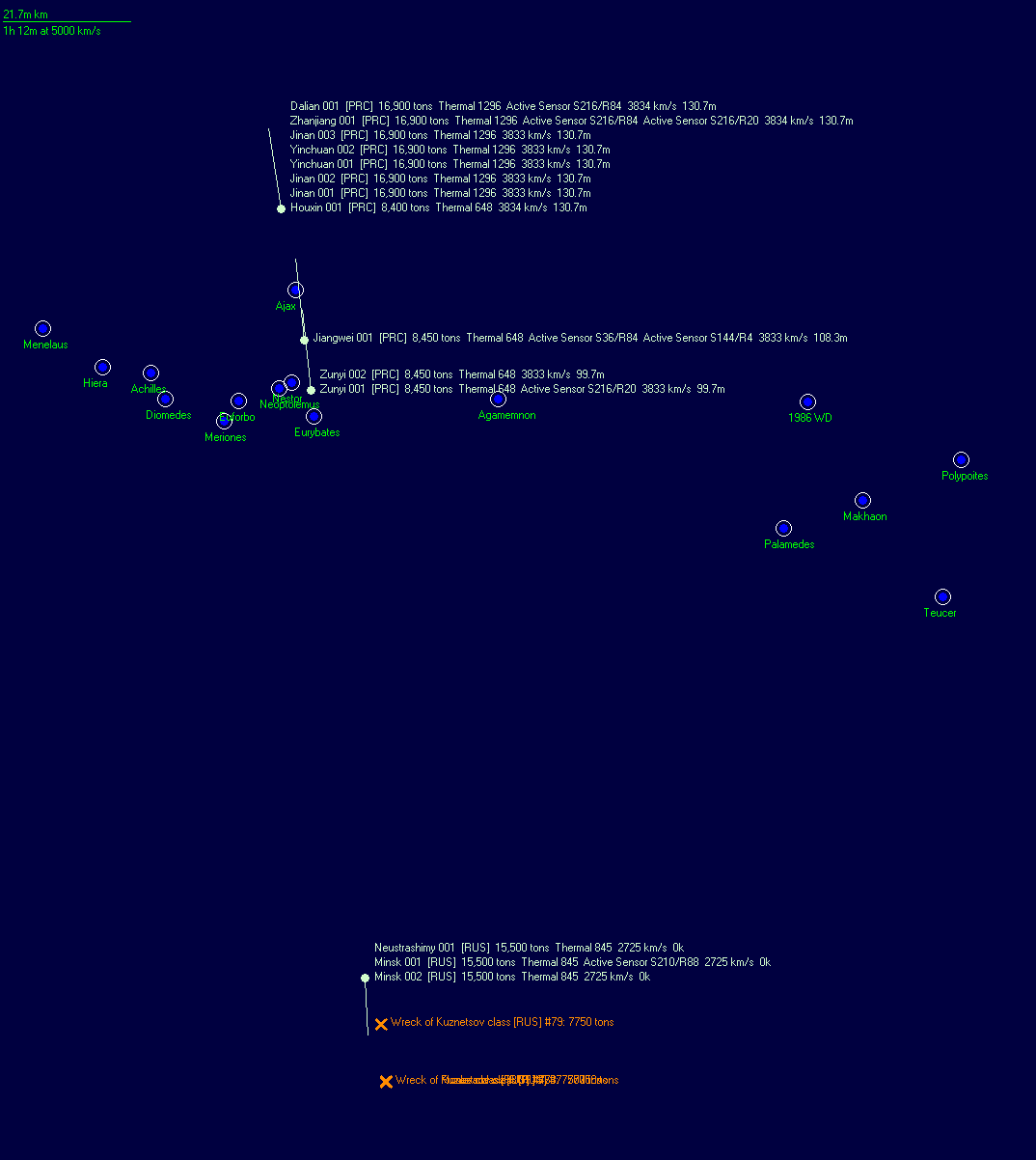
Once again the Russian task group came under missile attack as four strength-1 and four strength-3 energy weapon impacts were detected in the same location as the Russians. The Russian point defence proved just as effective as before, with a total of nine waves of missiles being engaged and destroyed without harm to the task group. One hour later, eight strength-1 detonations were detected within half a million kilometres of the Chinese main body. The Russians were apparently shooting back and the Chinese were engaging with anti-missiles. Those proved equally effective, destroying eight salvos with seven missiles in each, and no hits were scored. Fourteen minutes later, three strength-7 detonations struck one of a pair of Chinese Zunyi class destroyers that were preceding the main formation.
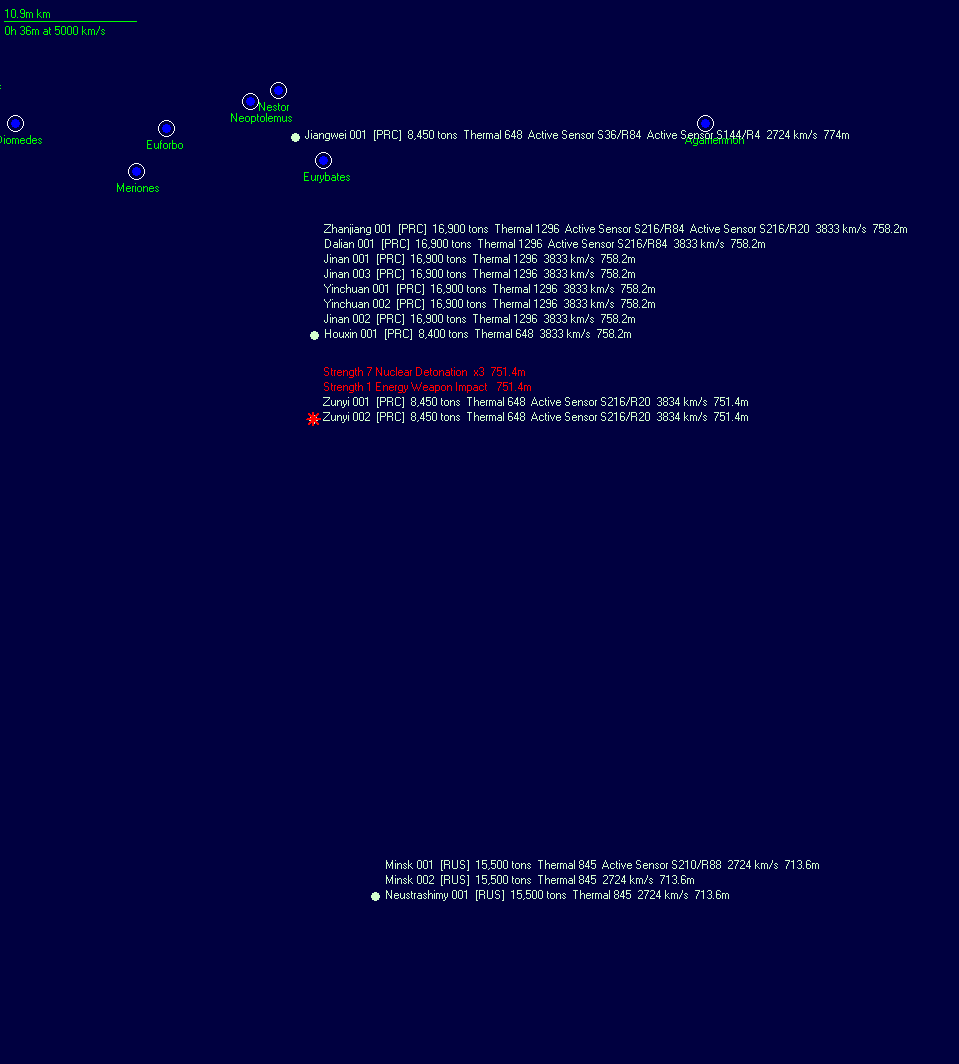
Thirty seconds later the destroyer was struck four more times and its thermal signature fell from 648 to 576, indicating engine damage. Four more salvos and another Chinese warship was destroyed by Chinese-built missiles. Less than a minute later the Jiangwei class destroyer at the rear of the Chinese formation suffered a single strength-7 hit, obviously from a missile fired much earlier. Three strength-1 energy weapon impacts were detected in the same location.
The two sides continued to close on one another. Forty minutes after the destruction of the Zunyi, the Russian task group was the target once more. Fifteen Chinese salvos of three missiles each were all destroyed by the Russian point defence. The Russians struck back four minutes later as the second Chinese Zunyi class destroyer was struck by missiles with strength-6 warheads. In total the destroyer suffered fourteen hits from several salvos but survived with reduced speed. The three Russian ships came about and begin heading toward the inner system. Less than ten minutes later they were under attack yet again, this time by six salvos of three missiles. None hit. Simultaneously, more strength-1 detonations were recorded close to the main Chinese force, signalling another wave of Russian anti-ship missiles.
The Chinese anti-missile missiles shot down almost every incoming Russian missile and the few leakers were handled by short-range point defence. Even so, none of the missiles expended by the Chinese could be replaced whereas the Russians still had their missile production facilities, even if production was still fairly limited. Furthermore, every missile expended in deep space battles with Russian warships was one less missile the Chinese would be able to use in an attempt to liberate their population on Earth. The small Russian task group continued sunward with the Chinese fleet in pursuit. Fifteen Chinese ships remained on Jovian sensors, two of which were Han class construction ships. Three more were warships much further out than the current combat area near the leading Jupiter Trojans, leaving ten warships in the main group. Two were known to be beam-armed and six others had resolution 1 sensors that indicated an escort vessel.
Main Force2x Yinchuan 16,900 tons (believed to be an escort - armament unknown)
3x Jinan 16,900 tons (believed to be an escort - armament unknown)
1x Dalian 16,900 tons (known to be laser armed)
1x Zhanjiang 16,900 tons (known to be laser armed)
1x Houxin 8,400 tons (believed to be an escort - armament unknown)
1x Jiangwei 8,400 tons
1x Zunyi 8,400 tons
Further out from Sol2x Kaifeng 25,350 tons
1x Huangwen 16,850 tons (probably missile ship)
2x Han 73,100 tons (Construction Ship)
The main Chinese formation continued to gain on the Russian task group and with the two sides twenty million kilometres apart combat resumed. A large number of energy weapon impacts were detected in the same location as the Russian ships, indicating a sustained Chinese attack. At first the missile salvos were small with two or three missiles in each. These increased to five, then seven and eventually twenty-four missiles per salvo. The first missiles to penetrate were twelve with strength-1 warheads from the first salvo of twenty-four that struck the Neustrashimy. For some reason this ship was running parallel to the two Minsk class at a distance of two hundred thousand kilometres. Given the range and warhead size the hits were almost certainly from Chinese anti-missiles. Twelve more detonations followed from each of the next three salvos.
Chinese salvos continued to arrive but on a smaller scale. Previous attacks on the Russian task group had been defended against by both strength-1 and strength-3 energy weapons. It now appeared the strength-3 energy weapons were based on the Neustrashimy as there were no defensive strength-3 impacts close to the two Minsks. Without the close protection of the Neustrashimy, the two Minsk class ships began to suffer hits from strength-1 warhead detonations as their own point defence was insufficient to hold off all the missiles from even the smaller salvos. After being under fire for over twenty minutes, with the incoming salvos only ten seconds apart, the larger salvos resumed, varying between twenty-four and thirty missiles. This time they were directed at the Minsk class ships, rather than the Neustrashimy, and the Minsks were far less able to defend themselves. Both Minsk class ships took significant damage. Minsk 002’s thermal signature dropped by twelve percent but Minsk 001 suffered more than two hundred strength-1 hits in barely over a minute and blew up.
The waves of Chinese anti-missiles were seemingly endless. After another brief respite, the pounding of the Russian ships resumed. The second Minsk did not last long, quickly succumbing to a barrage of hits. The Neustrashimy mounted a valiant defence but there were more incoming missiles than available point defence weapons. One by one its weapons fell silent and fewer missiles were intercepted in subsequent salvos. The end when it came was catastrophic, with multiple secondary explosions combining to destroy the ship.
Three Chinese ships from the main force, the two Yinchuans and the Houxin, remained in the general area of the battle. The other ships split up and visited the sites of the Russian wrecks, presumably to pick up survivors for interrogation, then headed for the inner system. They visited several wrecks within the asteroid belt then the Jiangwei and Zunyi reversed course while the Zhanjiang, Dalian and three Jinans continued onward, although not on a direct course for Earth, and halted at the inner edge of the asteroid belt. Two Russian 23,250 ton Kresta class battleships moved out toward them. The Chinese apparently detected the Krestas as they set an intercept course. A pair of 15,500 tons Kalinins were also in the area but one hundred million kilometres astern of the Krestas.
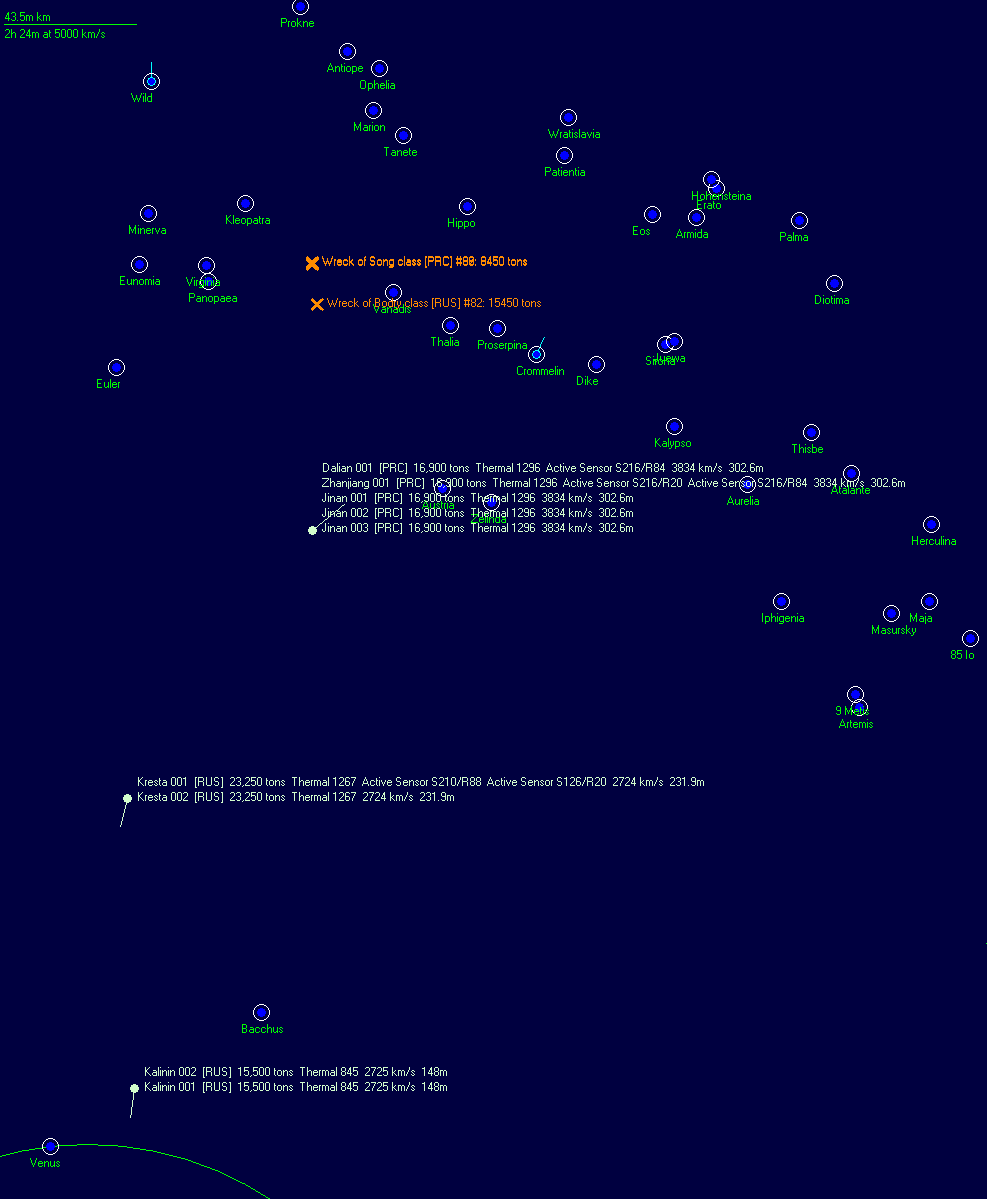
As the two sides reached eighty million kilometres apart, Jovian sensors detected eight energy weapon impacts and four strength-7 detonations in the same location as the Chinese Zhanjiang and Dalian class ships. Three of the energy weapon impacts were strength-1 and the other five were strength-2. The three Jinans were running parallel to the Zhanjiang and Dalian at a distance of 22,000 kilometres. The second wave of Russian missiles resulted in twelve energy weapon impacts and six strength-7 detonations. Four hits were scored in each and the third and fourth salvos, resulting in a small drop in the thermal signature of Zhanjiang 001. The three Jinans moved into close formation with the damaged Zhanjiang and no hits were scored from the fifth salvo, although seven strength-1 and ten strength-3 energy weapon impacts were detected.
Russian targeting changed to the Dalian, which had moved 50,000 kilometres ahead of the other four ships due to the engine damage of the Zhanjiang. Deprived of the protection of the Jinans, which appeared to be energy-armed point defence ships, it was an easy target. The Dalian took forty-seven hits from the next three salvos and exploded. Shortly thereafter the size of the Russian salvos was reduced to approximately twelve missiles, based on the amount of energy weapon interceptions. Possibly one of the battleships had run out of missiles. The Jinans held off the smaller salvos easily with only a few leakers getting through. Out of more than six hundred missiles, split between fifty-four salvos, just twenty-two struck their targets and those hits were distributed among the four Chinese ships. Once again energy-armed point defence combatants had defeated a significant missile attack. The two Russian battleships reversed course and moved away with the faster Chinese ships in pursuit.
In FL Virginis, two jumps from Sol via Wolf 359, the Jovian geological survey ship Oceanus was en route from the Wolf 359 jump point to outermost gas giant of the companion star. Because Oceanus was not equipped with a jump drive she had been escorted into the system by the gravitational survey ship Selene, which was now heading for an unexplored jump point in Wolf 359. What had seemed to be a routine mission became something else entirely when Oceanus detected the sensor emissions from two Secundus ships almost eight hundred million kilometres away but closing on her position at 4162 km/s. Her captain, Commander Ulysses Amodio, ordered an immediate course for the jump point. While Oceanus had no way to escape the system, her best option was to stay away from the Secundus until Selene returned. The Secundus had yet to commit a hostile act against a Federation ship but based on the events in Alpha Centauri, Amodio was not taking any chances.
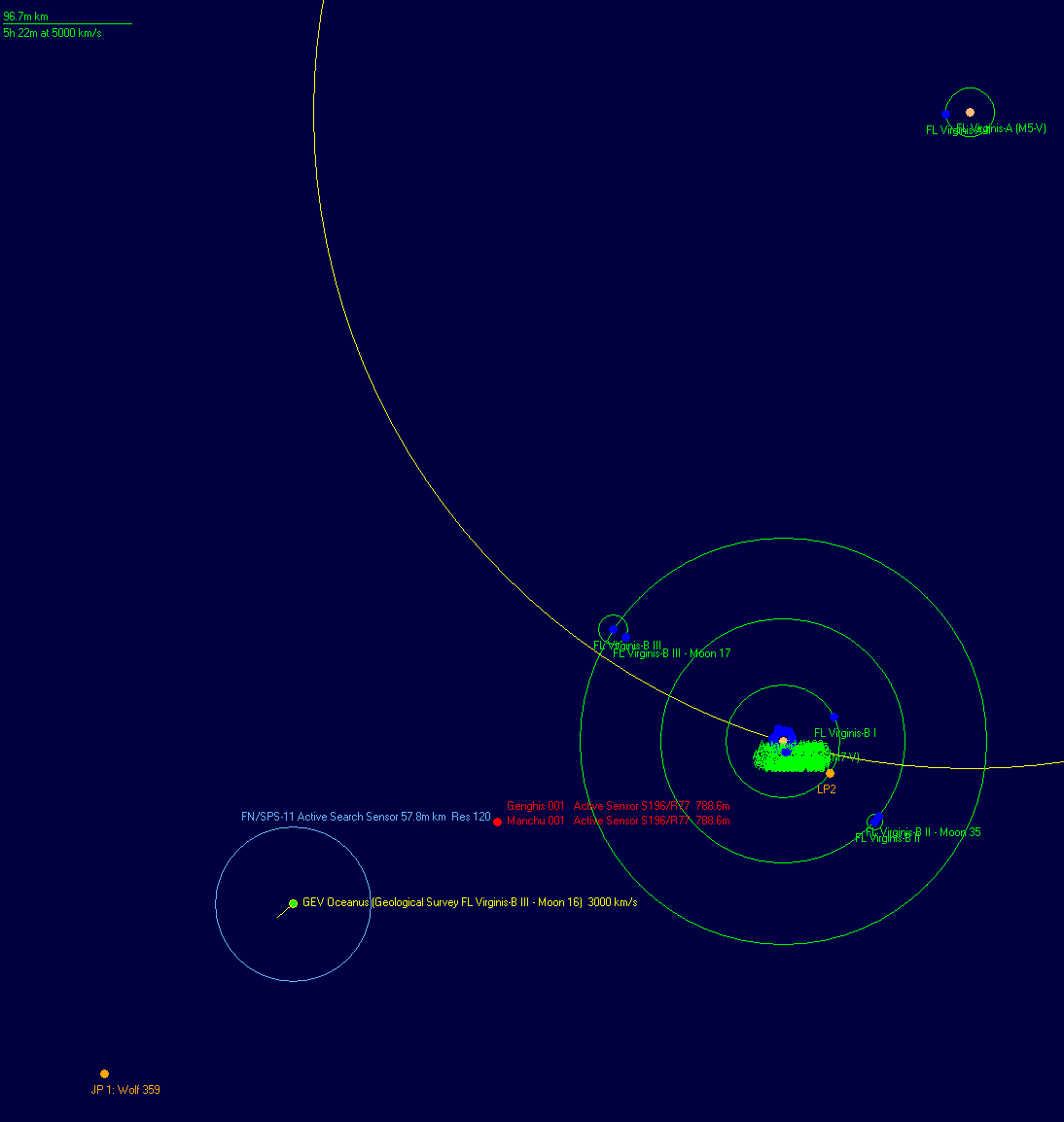
The two Russian Kresta class battleships turned to head for Earth, which lay on the far side of the Sun, with the Chinese task group closing rapidly. The two Kalinins were well ahead of the Krestas and also moving toward Earth. The Chinese intercepted the battleships just inside the orbit of Mercury and opened fire with lasers. The Russians were unable to respond and both 23,250 ton ships were ripped apart by a blizzard of energy fire. The Russian Federation was running out of warships. In addition to the two Kalinins, which were eighty million kilometres from the Chinese and still running for Earth, there were six bases in orbit of the Moon and a trio of destroyers, an Azov and two Kirovs, on the far side of the inner system, close to the orbit of Mars. The Chinese Zhenjiang and its three escorting Jinans set course for Earth.
to be continued...